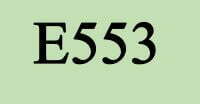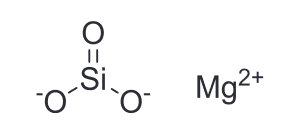What is E 553?
Food additive E553 has an anti-caking role and can be used as a carrier for other additives. It comes in two forms: E553a and E553b.
Which foods can E553 be added to?
Food additive E553 can be added in:
- salt and its substitutes
- powdered sugar
- dextrose
- whey powder and whey powder preparations
- sliced soft, hard or melted cheese
- spices and spreadable fats used for greasing pastry moulds, trays and pans
- all foods based on milk, meat, eggs, fish, cereals, sugar, vegetables, fruit, in alcoholic and non-alcoholic beverages, in diet products and dietary supplements
- products in tablet or powder form or for surface treatment only, according to the technologies and quantities laid down in the recipes
- food in tablet, pill or tablet form
- in shaved or sliced cheese substitutes and processed cheese substitutes.
Only talc is added to the chewing gum.
These additives can also be used in the surface treatment of jellies, confectionery (excluding chocolate) and in the surface treatment of sausages.[i]
Are there any side effects from consuming the food additive E553?
The US Food and Drug Administration (FDA), the European Food Safety Authority (EFSA) and the Joint FAO/WHO Expert Committee on Food Additives (JECFA) have concluded that magnesium silicate is safe for human consumption.
According to the studies conducted, silicate absorption was very low and there was no indication of genotoxicity or developmental toxicity and no adverse effects were observed. However, its safety cannot be assessed due to the lack of reliable data on sub-chronic and chronic toxicity, carcinogenicity and reproductive toxicity.[ii]
What are the characteristics of E553?
Magnesium silicate ( E553a)
Magnesium silicate is a synthetic compound whose molar ratio of magnesium oxide to silicon dioxide is approximately 2:5.
It occurs in two forms: magnesium orthosilicate (Mg2 SiO4 ) with M=140.7 g/mol and found in nature as forsterite. It is a colourless, water-insoluble substance crystallised in the rhombic system with a melting temperature of 1900º C and density d = 3.21. The second form is magnesium metasilicate Mg2 (Si2 O6 ), which is also called enstatite, having M = 200.7 g/mol. On heating, it decomposes at 1557º C. It occurs in crystallised form in the rhombic system, is a colourless substance with density d = 3.28. It is not soluble in water.
Talc (E553 b)
Talc is a clay mineral, composed of hydrated magnesium silicate found in nature, containing different proportions of associated minerals such as alkalite, calcite, chlorite, dolomite, magnesite and phlogopite. The product must not contain asbestos.[iii]
Talc deposits are found in several countries, including China, the United States, India, Brazil and France; different types of deposits occur depending on how the talc was formed and each type contains a different group of associated minerals. The purity of commercial products can be improved by either dry or wet processing. In both cases, talc ore is crushed and ground to a fine material before being mixed with water and a foaming agent (often a low molecular weight alcohol ). The air is bubbled through the suspension, which results in the flotation and sequestration of the talc particles and hence the removal of non-talc hydrophilic impurities. This process can be repeated several times to increase the purity of the talc. Magnetic separation or acid washing can be used to remove iron-bearing minerals, soluble salts and metals. Finally, the talc is filtered, washed and dried and can be heat sterilised.5
Chemically, it is a hydrated magnesium silicate with the chemical formula: Mg3 [(OH)2 Si4 O10 ] or 3MgO.4Si2 .H2 O. The additive contains: MgO 31.7%; SiO2 63.5%; H2 O 4%. It is a greenish-white, greyish-white, reddish-yellow, brown crystalline substance in the monoclinic system and occurs as thin, translucent or transparent sheets. It is greasy, pearly, slippery to the touch, without smell or taste. It is cleavable, has a hardness of 1, a specific gravity of 2,7 and can be scratched with a fingernail. It has a strong absorbent action.[iv]
It is insoluble in water and ethanol (Commission Regulation (EU) No 231/2012). Soluble in hot concentrated phosphoric acid.
Analysis of talc (E553b) with a scanning electron microscope (SEM) showed that the particles are irregularly shaped and non-porous and there are two different particle sizes of 40 and 20 µm.[v],[vi]
Maximum daily dose: The daily dose is not limited, it was established in 1982.[vii] Maximum inclusion dose: 10-30 g/kg
What are food additives?
According to the WHO (World Health Organisation), substances that are added to food to maintain or improve the safety, freshness, taste, texture or appearance of food are known as food additives. For centuries, food additives have been used to preserve food, for example salt (in meat, bacon or dried fish), sugar (in marmalade) or sulphur dioxide (in wine).
Over the years, many food additives have been developed to meet the needs of food production, because large-scale food manufacturing is much more complex than small-scale home production.
The introduction of additives into food is done with the aim of ensuring that processed foods remain safe and in good condition throughout their journey from factories or industrial kitchens to warehouses and shops and ultimately to consumers.
The use of food additives is only justified when their use has a technological need, does not mislead consumers and serves a well-defined technological function such as preserving the nutritional quality of the food or increasing the stability of the food.
Food additives can be derived from plants, animals or minerals, or they can be synthetic. They are intentionally added to food to fulfil certain technological purposes. There are several thousand food additives in use, all of which are designed to perform a specific task, usually to make food more durable or appealing.[viii]
Why is E553 necessary?
Magnesium silicates are used because they have anti-caking properties. They are added to dehydrated foods in powder form to prevent them from clumping.
They are also used for dry spraying purposes. Talc is used for glazing rice.
These additives are also used for surface treatments of some products, which are designed to prevent the action of external agents or to reduce moisture loss from the product.
As carrier substances they are only used for dyes3 .
How many categories do food additives fall into?
The World Health Organization (WHO)8 has grouped food additives, based on their function, into 3 broad categories as follows:
- Flavouring agents. These are added to foods to improve flavour or taste. Flavour enhancers are most commonly used in foods. There are hundreds of types of flavourings used in a wide variety of foods, from confectionery and soft drinks to cereals, cakes and yoghurt.
- Enzymes or enzyme preparations. They can be obtained by extraction from plants or animal products or from micro-organisms such as bacteria and are used as alternatives to chemical-based technology.
- Other additives. These are used for several reasons, such as: preservation, colouring and sweetening. They are added when food is being prepared, packaged, transported or stored and eventually become a component of the food.
How do we know that foods contain food additives?
According to the World Health Organization, practices, standards and guidelines on food labelling are established globally. These standards are implemented in most countries, and food manufacturers are obliged to indicate the additives present in their products. In the European Union, for example, there is legislation governing the labelling of food additives according to a set of pre-defined “E-numbers”. People with allergies or sensitivities to certain food additives should read labels carefully.
The World Health Organization encourages national authorities to monitor and ensure that food additives in foods and beverages produced in their countries comply with the uses, conditions and legislation.10
Conclusions and Legislative Regulations E553
Magnesium silicate E553a(i) and magnesium trisilicate E553a(ii) are listed in Commission Regulation (EU) No 231/2012 as authorised food additives and classified as “additives other than colours and sweeteners”.
As a result of the re-evaluation, additives in 2018, the panel of evaluators concluded that:
– Silicate and talc uptake was very low,
– there was no indication for genotoxicity or toxicity,
– despite the widespread and long-term use of these additives , there have been no confirmed cases of renal effects.
Author: dr.ing. Ancuta Fulvia Manolache
Bibliographical refer
[i] Commission Regulation (EU) No 1129/2011 of 11 November 2011 amending Annex II to Regulation (EC) No 1333/2008 of the European Parliament and of the Council by establishing a Union list of food additives
[ii] Re-evaluation of calcium silicate (E 552), magnesiumsilicate (E 553a(i)), magnesium trisilicate (E 553a(ii)) andtalc (E 553b) as food additives, https://efsa.onlinelibrary.wiley.com/doi/epdf/10.2903/j.efsa.2018.5375
[iii] Elena Oranescu, Food Additives-necessity and risk, SemnE Publishing House, 2005, Bucharest
[iv] COMMISSION REGULATION (EU) No 231/2012 of 9 March 2012 laying down specifications for food additives listed in Annexes II and III to Regulation (EC) No 1333/2008 of the European Parliament and of the Council
[v] https://efsa.onlinelibrary.wiley.com/doi/epdf/10.2903/j.efsa.2018.5375
[vi] https://foodadditives.net/anticaking-agent/magnesium-silicate/
[vii] https://apps.who.int/food-additives-contaminants-jecfa-database/Home/Chemical/4274
[viii] https://www.who.int/news-room/fact-sheets/detail/food-additives
9 https://pixabay.com/ro/photos/fri%c8%99c%c4%83-praf-crem%c4%83-pudra-b%c4%83utur%c4%83-4402671/


